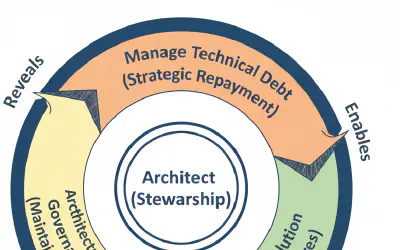The Decision Engine
Making Data-Driven Architectural Choices
Part of the From Patterns to Practice series
Introduction: The Final Tie-Breaker
So far in this series, you’ve followed a professional thought process. You started with a vague business conflict, analyzed the specific problem domain to derive concrete, measurable drivers, and then used those drivers to conduct a sophisticated analysis of three foundational architectural styles.
You now have a rich, qualitative understanding of the trade-offs. You know the Monolithic style is your fastest path to launch, while the distributed styles are better suited to your critical scalability needs. The analysis is solid, but it still leaves you with a dilemma. How do you actually choose?
This is where you move from analysis to a final decision. To do this, you need a tool that can resolve the contradictions by factoring in what the business values most. It’s time to introduce the heart of our framework: the Weighted Scoring Matrix. This is the engine that will turn your analysis into a number—a final, data-informed recommendation that is transparent and justifiable to everyone.
Step 1: Quantifying the Analysis with a Scorecard
First, you need to translate your qualitative analysis from the previous post into a semi-quantitative format. A simple scorecard is the perfect tool. You’ll score each architectural style (from 1 to 5) against each of your specific, measurable drivers for CityPulse. A score of 1 means the style poorly supports the driver, while a 5 means it provides excellent support.
Based on your deep analysis, you fill out the scorecard:
This scorecard is a powerful summary. It takes your analysis and distills it into a format that clearly shows the conflicting profiles: the Monolith is strong on the cost/speed axis, while the distributed styles are strong on the scale/performance axis.
Step 2: Applying Business Priorities with Weights
Now for the most important part of the process. To break the tie, you must apply the priorities of the business. As you established in your initial analysis, not all of these drivers are equally important. You do this by assigning a percentage “weight” to each driver. This is not a technical decision; it is a formal declaration of what the business cares about most. Facilitating the conversation to get these weights right is one of the most valuable things you can do as an architect.
After considering the existential pressures on CityPulse, you assign the weights:
- Time-to-Market: The CEO’s deadline is critical for survival. Weight: 40%
- Throughput Scalability: The engineer’s fear of a crash is equally critical. Weight: 30%
- Reliability (Transactional): Essential for user trust and payments. 15%
- Initial Cost: This focuses on the upfront cost of development and infrastructure (CapEx). For a startup, this is more critical than the long-term operational cost (OpEx), but still secondary to survival. 10%
- Performance (Under Load): Important, but partially covered by scalability. 5%
With your scores and your weights, the final step is simple multiplication (Score x Weight = Weighted Score). Let’s run the numbers in our final Weighted Scoring Matrix:
After summing the final weighted scores, the data gives you a clear, if surprising, winner. The Event-Driven style emerges with the highest score of 3.85, narrowly beating the Monolith at 3.80.
Architect's Log
This result makes me pause. The data points to Event-Driven, but my experience tells me this is where a purely mechanical process can lead you astray. The matrix is a powerful tool, but it’s a simplification; the real world is never so clean.The matrix provides a data-informed hypothesis, but it’s not the final answer. It doesn’t fully capture all real-world complexities. For instance, while the framework helps bring clarity to the messy realities of legacy systems, political pressures, and shifting requirements (which we explore in our Foundational Guide on real-world architectural pressures), it doesn’t erase them.
Crucially, the biggest missing piece here is Team Proficiency. For a team new to asynchronous programming, the risk of choosing an Event-Driven style is massive. You recognize this as a critical, external risk factor that needs consideration beyond just a line item in the matrix. (This is such a crucial topic that we’ve dedicated a Foundational Guide to analyzing the trade-offs of factoring in team skills.)
Therefore, you don’t blindly accept the matrix’s result. Instead, you use it as a tool to frame the next conversation. You propose a time-boxed spike to the engineering team: to build a ‘walking skeleton’ of the core ticket-purchasing flow using EDA. If the team can prove they can manage it, you proceed. If not, you default to the second-place, lower-risk option—the Monolith—and create a plan to manage its scalability challenges. The matrix gave you a hypothesis; the spike will give you the truth.
Key Takeaways:
- A qualitative analysis of trade-offs is not enough to make a final decision. You need to quantify your findings.
- Use a simple scorecard to rank each candidate style against your specific architectural drivers.
- The most critical step is assigning business weights to your drivers. This is what connects your technical decision to business value.
- The final weighted score provides a data-informed, transparent, and justifiable recommendation.
- Crucially, the matrix provides a hypothesis, not a final answer. Always consider external factors like team proficiency and validate high-risk choices with real-world experiments like spikes.
A Decision, Justified
So there you have it. You didn’t just “pick” an architecture. You followed a professional, repeatable process: you analyzed the problem, defined your drivers, profiled your options, and used a data-driven framework to make a choice.
The real power here isn’t the final number; it’s the process. You now have a transparent, documented, and justifiable case to present to your CEO and your lead engineer.
Of course, this formal matrix is just one tool in your toolbox. As we explore in our deep-dive on decision-making models, architects also rely on other techniques, from collaborative RFC processes to rapid prototyping. For a decision this critical, where the matrix result is close and the risk is high, you must combine your analytical model with one of those other techniques.
That’s why, in our next post, we’ll do just that. We will de-risk our choice by using a specific kind of prototype: the architectural spike.
Further Reading
- The Architectural Tradeoff Analysis Method (ATAM) is the formal, comprehensive evaluation method from the SEI that the Weighted Scoring Matrix is a simplified version of.
- Thinking, Fast and Slow by Daniel Kahneman. A masterclass on the cognitive biases that can influence stakeholders during the critical process of assigning weights to drivers.



